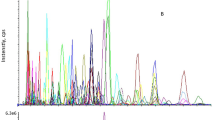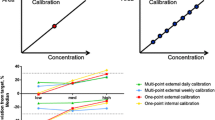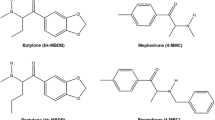Abstract
Purpose
We evaluated the use of dried blood spots (DBS) to determine seven NBOMes by liquid chromatography–tandem mass spectrometry (LC–MS/MS), and also evaluated the stability of these compounds in this dried matrix.
Methods
An LC–MS/MS method was developed and fully validated to quantify seven NBOMes (25C-, 25H-, 25I-, 25B-, 25G-, 25D- and 25E-NBOMe) in DBS samples. The extraction procedure was optimized using mixture design experiment. Stability study was performed in two different concentrations over 180 days at three different storage temperatures.
Results
Good linearity, and limits of detection and quantitation of 0.05 and 0.1 ng/mL, respectively, were obtained. The interday imprecision (n = 15) and bias (n = 15) were not higher than 11.4 and 10.3%, respectively, and no carryover was observed. All analytes remained stable in DBS at − 20, 4 °C and even at room temperatures for 180 days, except 25B-NBOMe and 25I-NBOMe which experienced degradation (22 and 21%, respectively) of the initial concentration at room temperature after 180 days of study. The method was applied to a DBS of an authentic postmortem blood from an NBOMe user, and it was found to be reliable with good selectivity and specificity.
Conclusions
DBS has been found to allow reliable, sensitive, accurate and robust detection and quantification of seven NBOMes via LC–MS/MS. Also, DBS provided great stability to most of the compounds at room temperature, and no degradation was observed for DBS kept at 4 and − 20 °C. This is the first trial to analyze NBOMes in DBS samples to our knowledge.





Similar content being viewed by others
References
Suzuki J, Dekker MA, Valenti ES, Cruz FAA, Correa AM, Poklis JL, Poklis A (2015) Toxicities associated with NBOMe ingestion—a novel class of potent hallucinogens: a review of the literature. Psychosomatics 56:129–139. doi:10.1016/j.psym.2014.11.002
Nichols DE, Sassano MF, Halberstadt AL, Klein LM, Brandt SD, Elliott SP, Fiedler WJ (2015) N-Benzyl-5-methoxytryptamines as potent serotonin 5-HT2 receptor family agonists and comparison with a series of phenethylamine analogues. ACS Chem Neurosci 6:1165–1175. doi:10.1021/cn500292d
Lawn W, Barratt M, Williams M, Horne A, Winstock A (2014) The NBOMe hallucinogenic drug series: patterns of use, characteristics of users and self-reported effects in a large international sample. J Psychopharmacol 28:780–788. doi:10.1177/0269881114523866
Kueppers VB, Cooke CT (2015) 25I-NBOMe related death in Australia: a case report. Forensic Sci Int 249:e15–e18. doi:10.1016/j.forsciint.2015.02.010
Walterscheid JP, Phillips GT, Lopez AE, Gonsoulin ML, Chen HH, Sanchez LA (2014) Pathological findings in 2 cases of fatal 25I-NBOMe toxicity. Am J Forensic Med Pathol 35:20–25. doi:10.1097/PAF.0000000000000082
Andreasen MF, Telving R, Rosendal I, Eg MB, Hasselstrøm JB, Andersen LV (2015) A fatal poisoning involving 25C-NBOMe. Forensic Sci Int 251:e1–e8. doi:10.1016/j.forsciint.2015.03.012
Rose SR, Poklis JL, Poklis A (2013) A case of 25I-NBOMe (25-I) intoxication: a new potent 5-HT2A agonist designer drug. Clin Toxicol 51:174–177. doi:10.3109/15563650.2013.772191
Tang MHY, Ching CK, Tsui MSH, Chu FKC, Mak TWL (2014) Two cases of severe intoxication associated with analytically confirmed use of the novel psychoactive substances 25B-NBOMe and 25C-NBOMe. Clin Toxicol 52:561–565. doi:10.3109/15563650.2014.909932
Hill SL, Doris T, Gurung S, Katebe S, Lomas A, Dunn M, Blain P, Thomas SHL (2013) Severe clinical toxicity associated with analytically confirmed recreational use of 25I-NBOMe: case series. Clin Toxicol 51:487–492. doi:10.3109/15563650.2013.802795
Kelly A, Eisenga B, Riley B, Judge B (2012) Case series of 25I-NBOMe exposures with laboratory confirmation. Clin Toxicol 50:702. doi:10.3109/15563650.2012.700015
Gee P, Schep LJ, Jensen BP, Moore G, Barrington S (2016) Case series: toxicity from 25B-NBOMe – a cluster of N-bomb cases. Clin Toxicol 54:141–146. doi:10.3109/15563650.2015.1115056
Kristofic JJ, Chmiel JD, Jackson GF, Vorce SP, Holler JM, Robinson SL, Bosy TZ (2016) Detection of 25C-NBOMe in three related cases. J Anal Toxicol 40:466–472. doi:10.1093/jat/bkw035
Poklis JL, Raso SA, Alford KN, Poklis A, Peace MR (2015) Analysis of 25I-NBOMe, 25B-NBOMe, 25C-NBOMe and other dimethoxyphenyl-N-[(2-methoxyphenyl) methyl]ethanamine derivatives on blotter paper. J Anal Toxicol 39:617–623. doi:10.1093/jat/bkv073
Poklis JL, Charles J, Wolf CE, Poklis A (2013) High-performance liquid chromatography tandem mass spectrometry method for the determination of 2CC-NBOMe and 25I-NBOMe in human serum. Biomed Chromatogr 27:1794–1800. doi:10.1002/bmc.2999
Poklis JL, Clay DJ, Poklis A (2014) High-performance liquid chromatography with tandem mass spectrometry for the determination of nine hallucinogenic 25-NBOMe designer drugs in urine specimens. J Anal Toxicol 38:113–121. doi:10.1093/jat/bku005
Li WK, Tse FLS (2010) Dried blood spot sampling in combination with LC-MS/MS for quantitative analysis of small molecules. Biomed Chromatogr 24:49–65. doi:10.1002/bmc.1367
Edelbroek PM, van der Heijden J, Stolk LM (2009) Dried blood spot methods in therapeutic drug monitoring: methods, assays, and pitfalls. Ther Drug Monit 31:327–336. doi:10.1097/FTD.0b013e31819e91ce
Koster RA, Touw DJ, Alffenaar J-WC (2015) Dried blood spot analysis; facing new challenges. J Appl Bioanal 1:38–41. doi:10.17145/jab.15.007
Raynie DE (2016) Supporting bioanalysis with dried blood spots. LC GC N Am 34:834–836. http://www.chromatographyonline.com/supporting-bioanalysis-dried-blood-spots. Accessed Sept 2017
Mercolini L, Mandrioli R, Sorella V, Somaini L, Giocondi D, Serpelloni G, Raggi MA (2013) Dried blood spots: liquid chromatography–mass spectrometry analysis of Δ9-tetrahydrocannabinol and its main metabolites. J Chromatogr A 1271:33–40. doi:10.1016/j.chroma.2012.11.030
Thomas A, Geyer H, Schanzer W, Crone C, Kellmann M, Moehring T, Thevis M (2012) Sensitive determination of prohibited drugs in dried blood spots (DBS) for doping controls by means of a benchtop quadrupole/Orbitrap mass spectrometer. Anal Bioanal Chem 403:1279–1289. doi:10.1007/S00216-011-5655-2
Kole PL, Majithia R, Singh TRR, Garland MJ, Migalska K, Donnelly RF, McElnay J (2011) Dried blood spot assay for estimation of metronidazole concentrations in rats and its application in single animal drug pharmacokinetic study. J Chromatogr B 879:1713–1716. doi:10.1016/j.jchromb.2011.03.060
Mommers J, Mengerink Y, Ritzen E, Weusten J, van der Heijden J, van der Wal S (2013) Quantitative analysis of morphine in dried blood spots by using morphine-d3 pre-impregnated dried blood spot cards. Anal Chim Acta 774:26–32. doi:10.1016/j.aca.2013.03.001
Saussereau E, Lacroix C, Gaulier JM, Goulle JP (2012) On-line liquid chromatography/tandem mass spectrometry simultaneous determination of opiates, cocainics and amphetamines in dried blood spots. J Chromatogr B 885:1–7. doi:10.1016/j.jchromb.2011.11.035
Jantos R, Veldstra JL, Mattern R, Brookhuis KA, Skopp G (2011) Analysis of 3,4-methylenedioxymetamphetamine: whole blood versus dried blood spots. J Anal Toxicol 35:269–273. doi:10.1093/anatox/35.5.269
Thomas A, Deglon J, Steimer T, Mangin P, Daali Y, Staub C (2010) On-line desorption of dried blood spots coupled to hydrophilic interaction/reversed-phase LC/MS/MS system for the simultaneous analysis of drugs and their polar metabolites. J Sep Sci 33:873–879. doi:10.1002/jssc.200900593
Mercolini L, Mandrioli R, Gerra G, Raggi MA (2010) Analysis of cocaine and two metabolites in dried blood spots by liquid chromatography with fluorescence detection: a novel test for cocaine and alcohol intake. J Chromatogr A 1217:7242–7248. doi:10.1016/j.chroma.2010.09.037
Ingels AS, Lambert WE, Stove CP (2010) Determination of gamma-hydroxybutyric acid in dried blood spots using a simple GC-MS method with direct “on spot” derivatization. Anal Bioanal Chem 398:2173–2182. doi:10.1007/s00216-010-4183-9
Alfazil AA, Anderson RA (2008) Stability of benzodiazepines and cocaine in blood spots stored on filter paper. J Anal Toxicol 32:511–515. doi:10.1093/jat/32.7.511
Scientific Working Group for Forensic Toxicology (SWGTOX) (2013) Standard practices for method validation in forensic toxicology. J Anal Toxicol 37:452–474. doi:10.1093/jat/bkt054
Shanks KG, Sozio T, Behonick GS (2015) Fatal Intoxications with 25B-NBOMe and 25I-NBOMe in Indiana during 2014. J Anal Toxicol 39:602–606. doi:10.1093/jat/bkv058
Lowe LM, Peterson BL, Couper FJ (2015) A case review of the first analytically confirmed 25I-NBOMe-related death in Washington State. J Anal Toxicol 39:668–671. doi:10.1093/jat/bkv092
Poklis JL, Devers KG, Arbefeville EF, Pearson JM, Houston E, Poklis A (2014) Postmortem detection of 25I-NBOMe [2-(4-iodo-2,5-dimethoxyphenyl)-N-[(2-methoxyphenyl)methyl]ethanamine] in fluids and tissues determined by high performance liquid chromatography with tandem mass spectrometry from a traumatic death. Forensic Sci Int 234:e14–e20. doi:10.1016/j.forsciint.2013.10.015
Youhnovski N, Bergeron A, Furtado M, Garofolo F (2011) Pre-cut dried blood spot (PCDBS): an alternative to dried blood spot (DBS) technique to overcome hematocrit impact. Rapid Commun Mass Spectrom 25:2951–2958. doi:10.1002/rcm.5182
De Kesel PMM, Capiau S, Lambert WE, Stove CP (2016) Current strategies for coping with the hematocrit problem in dried blood spot analysis. Bioanalysis 6:1871–1874. doi:10.4155/bio.14.151
Holub M, Tuschl K, Ratschmann R, Strnadová KA, Mühl A, Heinze G, Sperl W, Bodamer OA (2006) Influence of hematocrit and localisation of punch in dried blood spots on levels of amino acids and acylcarnitines measured by tandem mass spectrometry. Clin Chim Acta 373:27–31. doi:10.1016/j.cca.2006.04.013
O’Mara M, Hudson-Curtis B, Olson K, Yueh Y, Dunn J, Spooner N (2011) The effect of hematocrit and punch location on assay bias during quantitative bioanalysis of dried blood spot samples. Bioanalysis 3:2335–2347. doi:10.4155/bio.11.220
Antunes MV, Charão MF, Linden R (2016) Dried blood spots analysis with mass spectrometry: potentials and pitfalls in therapeutic drug monitoring. Clin Biochem 49:1035–1046. doi:10.1016/j.clinbiochem.2016.05.004
Wiergowski M, Aszyk J, Kaliszan M, Wilczewska K, Anand JS, Kot-Wasik A, Jankowski Z (2017) Identification of novel psychoactive substances 25B-NBOMe and 4-CMC in biological material using HPLC-Q-TOF-MS and their quantification in blood using UPLC-MS/MS in case of severe intoxications. J Chromatogr B 1041:1–10. doi:10.1016/j.jchromb.2016.12.018
Soh YNA, Elliott S (2014) An investigation of the stability of emerging new psychoactive substances. Drug Test Anal 6:696–704. doi:10.1002/dta.1576
Johnson RD, Botch-Jones SR, Flowers T, Lewis CA (2014) An evaluation of 25B-, 25C-, 25D-, 25H-, 25I-and 25T2-NBOMe via LC-MS-MS: method validation and analyte stability. J Anal Toxicol 38:479–484. doi:10.1093/jat/bku085
Poklis JL, Nanco CR, Troendle MM, Wolf CE, Poklis A (2014) Determination of 4-bromo-2,5-dimethoxy-N-[(2-methoxyphenyl)methyl]-benzeneethanamine (25B-NBOMe) in serum and urine by high performance liquid chromatography with tandem mass spectrometry in a case of severe intoxication. Drug Test Anal 6:764–769. doi:10.1002/dta.1522
Acknowledgements
The authors thank Fundação de Amparo à Pesquisa do Estado de São Paulo – FAPESP (Process Number 2015/10650-8), Conselho Nacional de Desenvolvimento Científico e Tecnológico – CNPq (Process Number 830525/1999-8), Fundo de Apoio ao Ensino, à Pesquisa e à Extensão – FAEPEX (Agreement 519.292 MF 86739) and Superintendência da Polícia Técnico-Científica.
Author information
Authors and Affiliations
Corresponding author
Ethics declarations
Conflict of interest
There are no financial or other relationships that could lead to a conflict of interest.
Ethical approval
All procedures performed in studies involving human participants were in accordance with the ethical standards of the institutional research committee (Comitê de Ética em Pesquisa da UNICAMP – CEP, CAAE 58452716.2.0000.5404 and Superintendência da Polícia Técnico-Científica, ofício No. 766/2015/ATS/SPTC-SSP) and with the 1964 Helsinki Declaration.
Rights and permissions
About this article
Cite this article
da Cunha, K.F., Eberlin, M.N. & Costa, J.L. Development and validation of a sensitive LC–MS/MS method to analyze NBOMes in dried blood spots: evaluation of long-term stability. Forensic Toxicol 36, 113–121 (2018). https://doi.org/10.1007/s11419-017-0391-8
Received:
Accepted:
Published:
Issue Date:
DOI: https://doi.org/10.1007/s11419-017-0391-8




